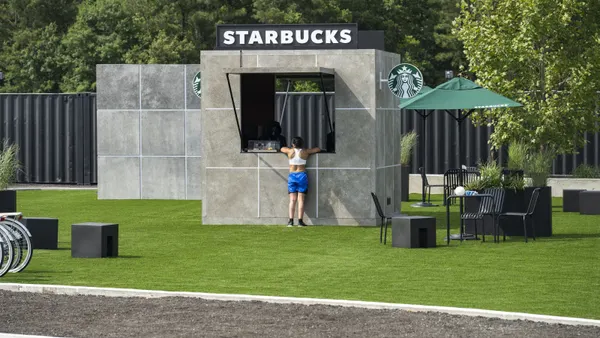Dive Brief:
- DoorDash drivers now have the opportunity to earn cash rewards by completing a certain number of deliveries each month, according to a company blog post Tuesday.
- This month, any Dasher who completes at least 450 deliveries will receive an additional $200 in their account in early February. The program also extends to Canadian and Australian drivers. Delivery goals and associated rewards will be announced on the first of each month.
- These rewards are an extension of the company's $12 million Dasher Rewards Program, first announced in November as part of its five-year, $200 million Main Street Strong Pledge. The program will last through May, and the rewards come in addition to what Dashers already earn with each delivery. Many Dashers have received cash rewards between $300 and $20,000 based on their lifetime deliveries as part of the initiative.
Dive Insight:
These new perks add to DoorDash's efforts to help deepen Dasher loyalty and attract new drivers. DoorDash partnered with Shell and Fuel Rewards during the summer with Shell and Fuel Rewards to offers savings of 10 cents per gallon when drivers fill up, for example. In 2019, DoorDash introduced a guaranteed minimum pay model, including tips, in response to complaints that drivers' earnings were not transparent. The company also started calculating earnings at scale so drivers could earn more on longer-distance deliveries and rolled out a "Promos" entry point so drivers could plan their schedule around peak pay hours. With those pay model changes, Dasher pay grew 12.5% on average, according to analysis from Beacon Economics.
Grubhub and Uber Eats also offer some benefits. Grubhub has a driver recognition program where workers can earn levels to unlock more opportunities, such as access to large catering orders. Its drivers also have access to discounts at partnership companies like QuickBooks Self-Employed, Stash and Jiffy Lube. Meanwhile, Uber has a program called Uber Eats Pro that rewards drivers with increased earnings and discounts on items like gas and 100% tuition coverage at Arizona State University.
Retention in the gig economy has long been a challenge, with some companies experiencing turnover rates as high as 500% per year, The Wall Street Journal reports. This level of churn exists despite the fact the share of workers in the U.S. gig economy has grown by 15% since 2010. According to a Stanford study of Uber drivers between 2015 and 2017, 68% of Uber drivers quit within six months. Turnover is expensive, including costs to onboard and train, as well as potential lapses in service standards.
Worker benefits are critical to retain drivers in the delivery space, especially as those drivers tend to not be loyal to any one delivery company, which can create inefficiencies in service times and experiences. Incentivizing drivers with loyalty programs and other benefits is an effective way to maintain their loyalty since these drivers are not employees and do not have access to many traditional benefits.










